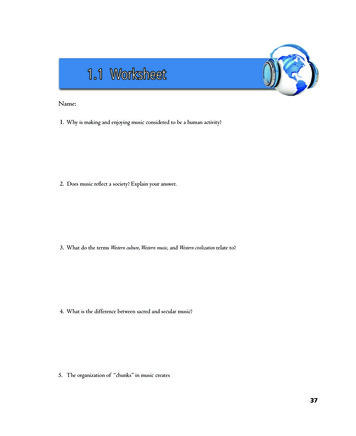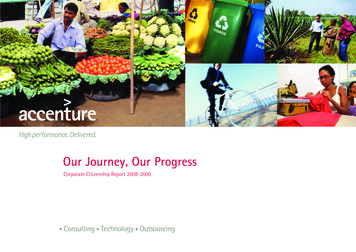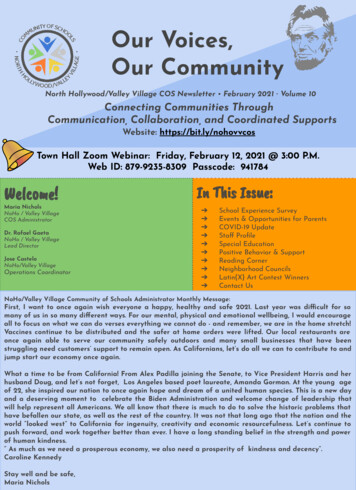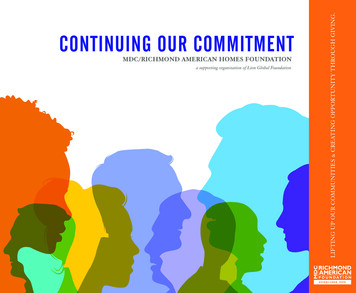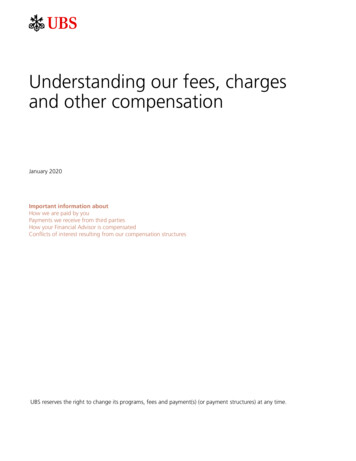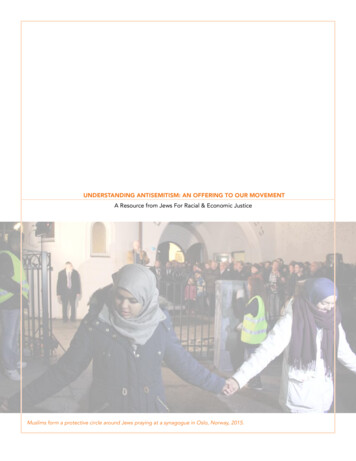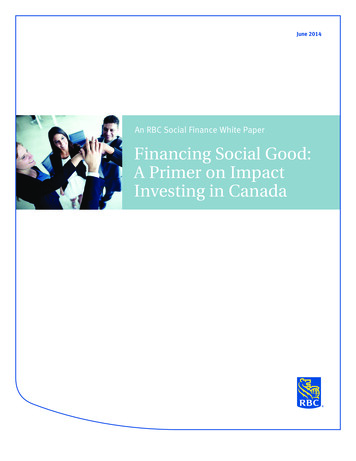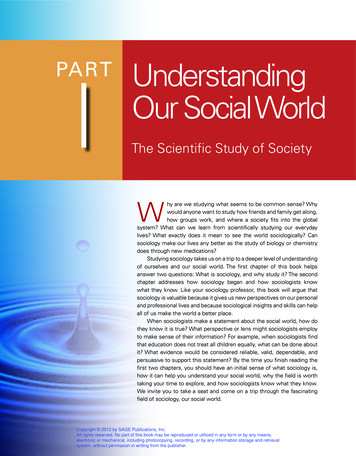
Transcription
PARTIUnderstandingOur Social WorldThe Scientific Study of SocietyWhy are we studying what seems to be common sense? Whywould anyone want to study how friends and family get along,how groups work, and where a society fits into the globalsystem? What can we learn from scientifically studying our everydaylives? What exactly does it mean to see the world sociologically? Cansociology make our lives any better as the study of biology or chemistrydoes through new medications?Studying sociology takes us on a trip to a deeper level of understandingof ourselves and our social world. The first chapter of this book helpsanswer two questions: What is sociology, and why study it? The secondchapter addresses how sociology began and how sociologists knowwhat they know. Like your sociology professor, this book will argue thatsociology is valuable because it gives us new perspectives on our personaland professional lives and because sociological insights and skills can helpall of us make the world a better place.When sociologists make a statement about the social world, how dothey know it is true? What perspective or lens might sociologists employto make sense of their information? For example, when sociologists findthat education does not treat all children equally, what can be done aboutit? What evidence would be considered reliable, valid, dependable, andpersuasive to support this statement? By the time you finish reading thefirst two chapters, you should have an initial sense of what sociology is,how it can help you understand your social world, why the field is worthtaking your time to explore, and how sociologists know what they know.We invite you to take a seat and come on a trip through the fascinatingfield of sociology, our social world.Copyright 2012 by SAGE Publications, Inc.All rights reserved. No part of this book may be reproduced or utilized in any form or by any means,electronic or mechanical, including photocopying, recording, or by any information storage and retrievalsystem, without permission in writing from the publisher.
CHAPTER1SociologyA Unique Way to View the WorldSociology involves a transformation in the way one seesthe world—learning to recognize the complex connectionsof our intimate personal lives with small groups, with largeorganizations and institutions, and with national and globalstructures and events.Copyright 2012 by SAGE Publications, Inc.All rights reserved. No part of this book may be reproduced or utilized in any form or by any means,electronic or mechanical, including photocopying, recording, or by any information storage and retrievalsystem, without permission in writing from the publisher.
Our Social World ModelGlobal CommunitySocietyIsal OrganizationtionNa , and Ethnic S anMe (and MyInner Circle)This model expresses a core idea carried throughout the book—the way in which your ownlife is embedded in, is shaped by, and influences your family, community, society, and world.It is a critically important reality that can make you a more effective person and a moreknowledgeable citizen.Copyright 2012 by SAGE Publications, Inc.All rights reserved. No part of this book may be reproduced or utilized in any form or by any means,electronic or mechanical, including photocopying, recording, or by any information storage and retrievalsystem, without permission in writing from the publisher.
4U n d e r s t a n d i n g O u r S o c i a l W o r l d : T h e S c i e nt i f i c S t u d y o f S o c i et yThink About ItSelf and Inner CircleHow can sociology help me understand my own life and my sense of self?Local CommunityHow can sociology help me to be a more effective employee and citizen in my community?National Institutions; ComplexOrganizations;Ethnic GroupsHow do sociologists help us understand and even improve our lives in families, classrooms, andhealth care offices?National SocietyHow do national loyalty and national policies affect my life?Global CommunityHow might global events affect my life?“It may win the prize for the strangest place to geta back massage,” but according to a recent scientific article, twins do a good deal of it (Weaver2010). Scientists studied the movement of five pairs of twinfetuses using ultrasonography, a technique that visualizesinternal body structures. By the fourth month of gestation,twin fetuses begin reaching for their “womb-mates,” and by18 weeks, they spend more time touching their neighborsthan themselves or the walls of the uterus. Fetuses thathave single-womb occupancy tend to touch the walls ofthe uterus a good deal to make contact with the mother.Nearly 30% of the movement of twins was directed towardtheir companions. Movements toward the partner, such asstroking the back of the head, are more sustained and moreprecise than movements toward themselves, such as touching their own mouths or other facial features. As the authorsWithin hours after their birth in October 2010, Jackson and AudreyPietrykowski became highly fussy if the nurses tried to put them inseparate bassinets. At one point shortly after birth, both babies wereput in a warmer, and Jackson cried until he found Audrey, proceedingto intertwine his arms and legs with hers. Twins, like all humans, arehardwired to be social and in relationships with others.put it, they’re “wired to be social” (Castiello et al. 2010). Inshort, humans are innately social creatures.Strange as it may seem, the social world is not merelysomething that exists outside of us. As the twins illustrate, thesocial world is also something we carry inside of us. We arepart of it, we reflect on it, and we are influenced by it, evenwhen we are alone. The patterns of the social world engulf usin ways both subtle and obvious, with profound implicationsfor how we create order and meaning in our lives.Sometimes it takes a dramatic and shocking event forus to realize just how deeply embedded we are in a socialworld that we take for granted. “It couldn’t happen in theUnited States,” read typical world newspaper accounts.“This is something you see in Bosnia, Kosovo, the MiddleEast, Central Africa, and other war-torn areas. . . . It’s hardto imagine this happening in the economic center of theUnited States.” Yet on September 11, 2001, shortly after9 a.m., a commercial airliner crashed into a New York Cityskyscraper, followed a short while later by another pummeling into the paired tower, causing this mighty symbolof financial wealth—the World Trade Center—to collapse.After the dust settled and the rescue crews finished theirgruesome work, nearly 3,000 people were dead or unaccounted for. The world as we knew it changed forever thatday. This event taught U.S. citizens how integrally connected they are with the international community.Following the events of September 11, the United Stateslaunched its highly publicized War on Terror, and manyterrorist strongholds and training camps were destroyed.Still, troubling questions remain unanswered. Why did thisextremist act occur? How can such actions be deterred inthe future? How do the survivors recover from such a horrific event? Why was this event so completely disorienting toAmericans and to the world community? These terrorist actshorrified people because they were unpredicted and unexpected in a normally predictable world. They violated therules that foster our connections to one another. They alsobrought attention to the discontent and disconnectednessthat lie under the surface in many societies—discontent thatexpressed itself in hateful violence. That discontent and hostility is likely to continue until the root causes are addressed.Terrorist acts represent a rejection of modern civil society (Smith 1994). The terrorists themselves see their acts asCopyright 2012 by SAGE Publications, Inc.All rights reserved. No part of this book may be reproduced or utilized in any form or by any means,electronic or mechanical, including photocopying, recording, or by any information storage and retrievalsystem, without permission in writing from the publisher.
Chapter 1. Sociology: A Unique Way to View the WorldThese signs were put up right after the September 11 attacks on the World Trade Center by people looking for missing loved ones.The experience of New Yorkers was alarm, fear, grief, and confusion—precisely the emotions that the terrorists sought to create.Terrorism disrupts normal social life and daily routines and undermines security. It provides an effective tool for those with no power.justifiable, but few outside their inner circle can sympathizewith their behavior. When terrorist acts occur, we struggle tofit such events into our mental picture of a just, safe, comfortable, and predictable social world. The events of September11 forced U.S. citizens to realize that, although they may seea great diversity among themselves, people in other parts ofthe world view them as all the same. U.S. citizens may alsobe despised for what they represent, as perceived by others.In other words, terrorists view U.S. citizens as intimately connected. For many U.S. citizens, their sense of loyalty to thenation was deeply stirred by the events of 9/11. Patriotismabounded. So, in fact, the nation’s people became more connected as a reaction to an act against the United States.Most of the time, we live with social patterns thatwe take for granted as routine, ordinary, and expected.These social patterns, or social facts, characterize socialgroups. The social expectations are external to each individual (unlike motivations or drives), but they still guide(or constrain) our behaviors and thoughts. Without sharedexpectations between humans about proper patterns ofbehavior, life would be chaotic. Connections require somebasic rules of interaction, and these rules create routine andsafe normality in everyday interaction. For the people inand around the World Trade Center, the social rules governing everyday life broke down that awful day. How couldanyone live in society if there were no rules?This first chapter examines the social ties that make upour social world, as well as sociology’s focus on those ties.We will learn what sociology is and why it is valuable tostudy it; how sociologists view the social world and whatthey do; how studying sociology can help us in our everyday life; and how the social world model is used to presentthe topics we will study throughout this book.What Is Sociology?Whether we are in a coffee shop, in a classroom, in a dininghall, at a party, in our residence hall, at work, or withinour home, we interact with other people. Such interactionsCopyright 2012 by SAGE Publications, Inc.All rights reserved. No part of this book may be reproduced or utilized in any form or by any means,electronic or mechanical, including photocopying, recording, or by any information storage and retrievalsystem, without permission in writing from the publisher.5
6U n d e r s t a n d i n g O u r S o c i a l W o r l d : T h e S c i e nt i f i c S t u d y o f S o c i et yare the foundation of social life, and they are the subjectof interest to sociologists. According to the AmericanSociological Association (2002),Sociology is the scientific study of social life, socialchange, and the social causes and consequences ofhuman behavior. Since all human behavior is social,the subject matter of sociology ranges from the intimatefamily to the hostile mob; from organized crime to religious cults; from the divisions of race, gender, and socialclass to the shared beliefs of a common culture; and fromthe sociology of work to the sociology of sports. (p. 1)As we shall see, sociology is relevant and applicableto our lives in many ways. Sociologists conduct scientificresearch on social relationships and problems that rangefrom tiny groups of two people to national societies andglobal social networks.Unlike the discipline of psychology, which focuseson attributes, motivations, and behaviors of individuals,sociology tends to focus on group patterns. Whereas a psychologist might try to explain behavior by examining thepersonality traits of individuals, a sociologist would examine the position of different people within the group andhow positions influence what people do. Sociologists seekto analyze and explain why people interact with others andbelong to groups, how groups work, who has power andwho does not, how decisions are made, and how groupsdeal with conflict and change. From the early beginnings oftheir discipline (discussed in Chapter 2), sociologists haveasked questions about the rules that govern group behavior;about the causes of social problems, such as child abuse,crime, and poverty; and about why nations declare war andkill each other’s citizens.Two-person interactions—dyads—are the smallest unitssociologists study. Examples of dyads include roommatesdiscussing their classes, a professor and student going overan assignment, a husband and wife negotiating their budget,and two children playing. Next in size are small groups consisting of three or more interacting people—a family, a neighborhood or peer group, a classroom, a work group, or a streetgang. Then come increasingly larger groups—organizationssuch as sports or scouting clubs, neighborhood associations,and local religious congregations. Among the largest groupscontained within nations are ethnic groups and nationalorganizations, including economic, educational, religious,health, and political systems. Nations themselves are stilllarger and can sometimes involve hundreds of millions ofpeople. In the past several decades, social scientists havealso pointed to globalization, the process by which the entireworld is becoming a single interdependent entity. Of particular interest to sociologists are how these various groups areorganized, how they function, why they conflict, and howthey influence one another.Thinking SociologicallyIdentify several dyads, small groups, and large organizationsto which you belong.
gruesome work, nearly 3,000 people were dead or unac-counted for. The world as we knew it changed forever that day. This event taught U.S. citizens how integrally con-nected they are with the international community. Following the events of September 11, the United States launched its highly publicized War on Terror, and many
